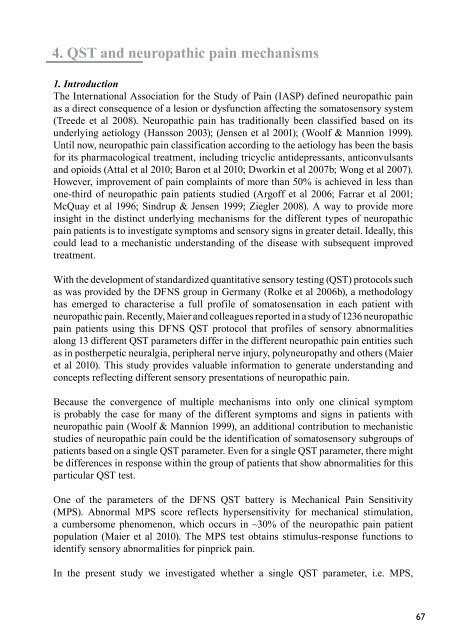Quantitative Sensory Testing (QST) - Does assessing ... - TI Pharma
Quantitative Sensory Testing (QST) - Does assessing ... - TI Pharma
Quantitative Sensory Testing (QST) - Does assessing ... - TI Pharma
Create successful ePaper yourself
Turn your PDF publications into a flip-book with our unique Google optimized e-Paper software.
4. <strong>QST</strong> and neuropathic pain mechanisms<br />
1. Introduction<br />
The International Association for the Study of Pain (IASP) defined neuropathic pain<br />
as a direct consequence of a lesion or dysfunction affecting the somatosensory system<br />
(Treede et al 2008). Neuropathic pain has traditionally been classified based on its<br />
underlying aetiology (Hansson 2003); (Jensen et al 2001); (Woolf & Mannion 1999).<br />
Until now, neuropathic pain classification according to the aetiology has been the basis<br />
for its pharmacological treatment, including tricyclic antidepressants, anticonvulsants<br />
and opioids (Attal et al 2010; Baron et al 2010; Dworkin et al 2007b; Wong et al 2007).<br />
However, improvement of pain complaints of more than 50% is achieved in less than<br />
one-third of neuropathic pain patients studied (Argoff et al 2006; Farrar et al 2001;<br />
McQuay et al 1996; Sindrup & Jensen 1999; Ziegler 2008). A way to provide more<br />
insight in the distinct underlying mechanisms for the different types of neuropathic<br />
pain patients is to investigate symptoms and sensory signs in greater detail. Ideally, this<br />
could lead to a mechanistic understanding of the disease with subsequent improved<br />
treatment.<br />
With the development of standardized quantitative sensory testing (<strong>QST</strong>) protocols such<br />
as was provided by the DFNS group in Germany (Rolke et al 2006b), a methodology<br />
has emerged to characterise a full profile of somatosensation in each patient with<br />
neuropathic pain. Recently, Maier and colleagues reported in a study of 1236 neuropathic<br />
pain patients using this DFNS <strong>QST</strong> protocol that profiles of sensory abnormalities<br />
along 13 different <strong>QST</strong> parameters differ in the different neuropathic pain entities such<br />
as in postherpetic neuralgia, peripheral nerve injury, polyneuropathy and others (Maier<br />
et al 2010). This study provides valuable information to generate understanding and<br />
concepts reflecting different sensory presentations of neuropathic pain.<br />
Because the convergence of multiple mechanisms into only one clinical symptom<br />
is probably the case for many of the different symptoms and signs in patients with<br />
neuropathic pain (Woolf & Mannion 1999), an additional contribution to mechanistic<br />
studies of neuropathic pain could be the identification of somatosensory subgroups of<br />
patients based on a single <strong>QST</strong> parameter. Even for a single <strong>QST</strong> parameter, there might<br />
be differences in response within the group of patients that show abnormalities for this<br />
particular <strong>QST</strong> test.<br />
One of the parameters of the DFNS <strong>QST</strong> battery is Mechanical Pain Sensitivity<br />
(MPS). Abnormal MPS score reflects hypersensitivity for mechanical stimulation,<br />
a cumbersome phenomenon, which occurs in ~30% of the neuropathic pain patient<br />
population (Maier et al 2010). The MPS test obtains stimulus-response functions to<br />
identify sensory abnormalities for pinprick pain.<br />
In the present study we investigated whether a single <strong>QST</strong> parameter, i.e. MPS,













